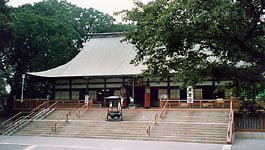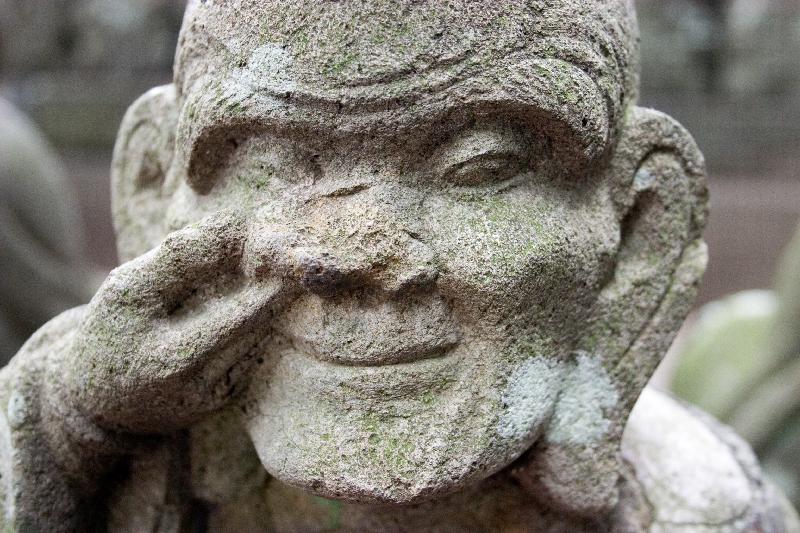If you have an interest in traditional Japanese architecture and can’t get out of the Tokyo area, Kawagoe city in Saitama Prefecture is definitely worth a visit.
It’s an old castle town and has quite a few old kura (stone buildings) and an interesting temple called Kita-in. Kura were originally small stone storehouses that were built beside a person’s house to store valuables in. Most Japanese buildings were made of wood, but the kura’s stone construction helped to prevent fire and theft. In Kawagoe, however, the kura have evolved into regular shops and houses. Kura were very expensive to build, and they were only common in wealthy commercial centers, such as Kawagoe, which provided rice and timber to nearby Edo (modern-day Tokyo).
There used to be about 200 kura in Kawagoe, but, now, just a few dozen remain. Most of them are in the “Kura-zukuri” zone north of the station. Kawagoe doesn’t compare with Shirakawa-go, Takayama, or the old post towns of the Naka-sendo, because most of the houses are on crowded streets with heavy traffic, but some of the buildings are gorgeous.
Kawagoe’s symbol is the Toki no Kane, the Bell of Time. Built between 1624 and 1643, it was destroyed three times in the numerous fires that swept through the city. The latest incarnation was rebuilt in 1893. You can’t actually go in it, but everyone stops by to take a photo.
 Kita-in, an important temple was founded in the ninth century. It’s dedicated to Muryoju (Amitabha), the Buddha of unending life, and was formerly the main temple of the Tendai Sect, but to me, it’s the Nose Picking Buddha Temple. There are hundreds of rakan butsu-zo, statues representing the 500 disciples of Buddha. Although many Buddhist sculptures are carved to represent exquisite beauty or terrifying ferociousness, rakan almost always seem to be carved in the spirit of humour and good fun. For more details on the temple, visit the official homepage in English at: http://www.kawagoe.com/kitain/english/index.html
Kita-in, an important temple was founded in the ninth century. It’s dedicated to Muryoju (Amitabha), the Buddha of unending life, and was formerly the main temple of the Tendai Sect, but to me, it’s the Nose Picking Buddha Temple. There are hundreds of rakan butsu-zo, statues representing the 500 disciples of Buddha. Although many Buddhist sculptures are carved to represent exquisite beauty or terrifying ferociousness, rakan almost always seem to be carved in the spirit of humour and good fun. For more details on the temple, visit the official homepage in English at: http://www.kawagoe.com/kitain/english/index.html

Another place of potential interest is the Honmaru Goten, a palace that was once part of Kawagoe castle. It was built in 1848 and is interesting because many palaces in Japan were were built of wood and have not survived as well as the stone castles they were attached to. (In this case, however, the palace has survived and there is nothing left to see of the castle.)
Address : 2-13-1 Kuruwa-machi, Kawagoe City, Saitama Prefecture, TEL : 049-224-6015, Hours : 9:00 – 17:00, Admission : Adults 400 yen, Students (primary school, junior high school) 200 yen, Holidays : Every Monday (excluding Mondays that follow a holiday or the Kawagoe festival), days following holidays (excluding Saturdays and Sundays), 4th Friday of the month (excluding holidays), Dec 28 – Jan 4
 The city’s museum is actually quite a good one, very modern and with attractive, interesting displays. It starts with displays on the ancient history of the area, and some of the artifacts from the Jomon Period are amazing. The next sections detail life for the samurai class during Japan’s middle ages, and in the Edo Period (1603-1867), and there are lots of beautiful examples of Japanese handicrafts, clothes, and weapons. There’s also a section on more recent history, and an area dealing with the city’s famous festivals.
The city’s museum is actually quite a good one, very modern and with attractive, interesting displays. It starts with displays on the ancient history of the area, and some of the artifacts from the Jomon Period are amazing. The next sections detail life for the samurai class during Japan’s middle ages, and in the Edo Period (1603-1867), and there are lots of beautiful examples of Japanese handicrafts, clothes, and weapons. There’s also a section on more recent history, and an area dealing with the city’s famous festivals.
Address : 2-30-1 Kuruwa-machi Kawagoe City Saitama Prefecture, TEL:049-222-5399, Hours : 9:00 – 17:00 ( Admission until 16:00 ), Admission : Adults 200 yen, Students (senior high school, university) 100 yen, Children under junior high school Free, Holidays : Every Monday (excluding Mondays that follow a holiday or the Kawagoe festival), days following holidays (excluding Saturdays and Sundays), 4th Friday of the month (excluding holidays), Dec 28 – Jan 4 http://museum.city.kawagoe.saitama.jp/ (Japanese only)
Kawagoe has a popular festival held on the third weekend in October, in which huge floats are pulled through the streets. Photoguide.jp has lots of pictures of the festival. If you’re not there in October, you can see two of the city’s 29 floats at the small but interesting festival museum.
Kawagoe Festival Museum
Address : 2-1-10 Moto-machi, Kawagoe City, Saitama Prefecture, TEL:049-225-2727, Hours : April – September 9:00 – 18:30 ( Admission until 18:00 ), October – March 9:30 – 17:30 ( Admission until 17:00)
Admission : General 300 Yen, Students (elementary school, junior high school ) 100 Yen, Holidays : Every 2nd and 4th Wednesday (in case of holidays, the next day) Dec 29 – Jan 1
There is also a huge fireworks display held every year in mid-July. Check the Japan Times festivals page for details.
Getting there:
JR, Seibu Railways, and Tobu Railways all operate services to Kawagoe.
JR: Saikyo Line to Kawagoe Station, 650 yen, 44 min. (The JR station is the furthest from the main sights)
Seibu: Honkawagoe Station, 450 yen, 51 minutes (Change at Tokorozawa, Honkawagoe Station is closest to the main sights)
Tobu: Kawagoe Station or Kawagoe-shi Station, Tobu Tojo Line, 450 yen, 37 minutes (Kawagoe-shi Station is closer to the sights)
The Kura-zukuri area is about 15 minutes walk from Honkawagoe Station, and about 20 minutes from the Tobu and JR stations. Kita-in and the Honmaru Goten are about ten minutes from the Kura-zukuri area. There’s more travel information here.
Other information in English:
Official site: http://www.koedo.or.jp/foreign/english/sight/sight_high.htmlJapan Guide – http://www.japan-guide.com/e/e6500.html
Map in English at: http://www.koedo.or.jp/foreign/english/pdf/kawagoe_map_english.pdfEvent information listings: http://www.koedo.or.jp/foreign/english/pdf/kawagoe_event_e.pdf





That’s very funny, I recently went to Kawagoe for the first time on September 27th!
http://jasoncollin.org/2008/09/28/scenes-from-kawagoe-saitama-japan/
Did you go in that knife store in your photo? I liked it a lot. You can try out their knives’ sharpness by cutting an onion right in the shop! A student told me today that house was well over 100 years old. She was invited upstairs by the owner.
Most kura were not made of stone. They were sometimes built on a stone base to reduce insect damage. They normally were built with a wooden frame. The spaces were filled with bamboo and/or wood, then covered with mud and plaster.
Stone and brick buildings do not do well in earthquakes.